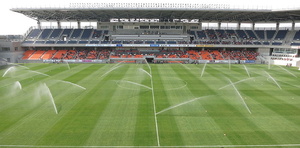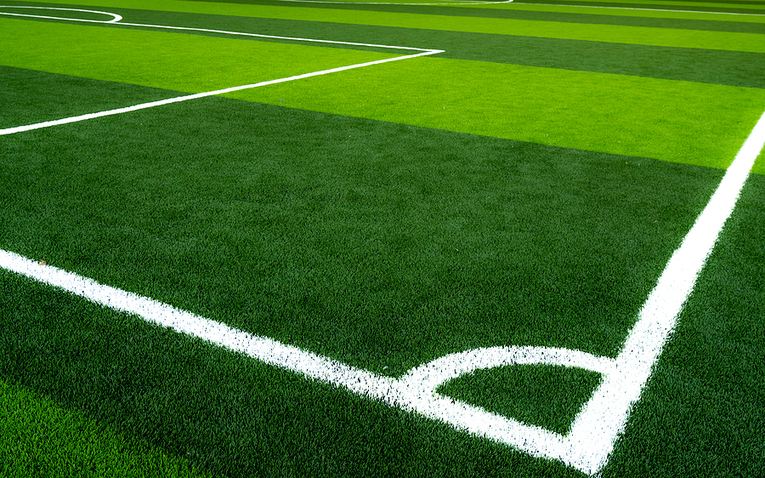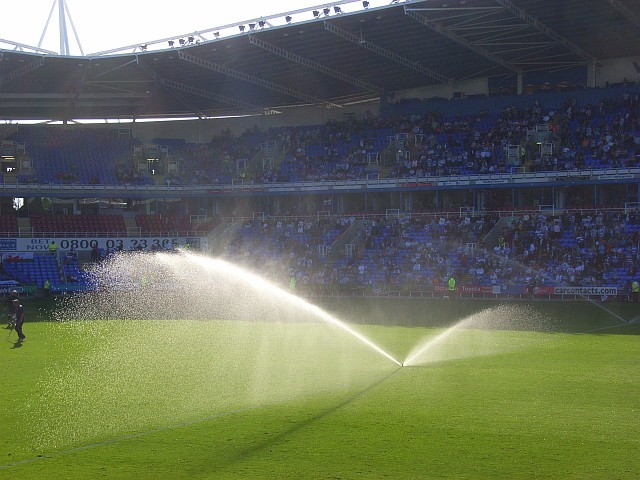
We’ve all seen it happen, either live in person or on video clips on YouTube.
Some poor, unsuspecting groundskeeper is doing some work on the football pitch at half-time when all of a sudden the sprinkler system comes on and they get absolutely soaking wet.
Or, perhaps more amusingly, the sprinkler isn’t working properly and a load of people in the first couple of rows of the crowd get soaked as it aims its spray at them and the water goes all over them.
But why are sprinkler systems used in the first place? What’s the point in them? Is it just about the maintenance of the pitch or can managers use sprinklers tactically?
We’ve had a look.
Why Sprinkler Systems Are Used At All?

One of the most obvious answers to the question of why a sprinkler system is used at all is that it’s necessary for the maintenance of a healthy pitch. To grow well grass needs a decent amount of light and the correct amount of water put on it on a regular basis.
In the past this would be down to the groundskeepers walking over the pitch with watering cans, sprinkling the grass that needed it the most in order to keep it in a healthy state.
Nowadays the systems have become a lot more efficient and effective. Sprinklers can be hidden deep under the surface of the turf and brought up before the match to spray water over the pitch.
The system can be automated to work at specific times every day of the year and for specific lengths of time, too.
If it rains heavily then the sprinklers can be cancelled in order to ensure a pitch doesn’t get over-watered or, even worse, waterlogged. This is especially important if you’re dealing with a newly laid and seeded pitch or when a pitch is being renovated and revitalised.
How Sprinkler Systems Work

The way sprinkler systems work at top-level football clubs is genuinely fascinating. Whilst an entry level system would generally tend to consist of a water storage tank and booster pump that feed into a portable sprinkler system that you can place in different places over the field, a professional club’s system will be much more sophisticated.
Reel irrigators are the first step towards a fully automated system and can be left unattended. when they have completed their run they will switch themselves off automatically, meaning that they don’t need to be constantly watched over. Yet it is in the premium system that most top-level clubs have installed that you’ll find the real fun.
Fully automated systems allow clubs to programme their watering system to do any number of jobs. If they’re just bedding in a new pitch then they can set up the sprinklers to aid with that. Deep-watering is also a possibility, as is pre-match and half-time watering and a method of aiding the pitch in the period after fertilisation. Four millimetres of water can be applied to a pitch in three hours using a full system, all activated from a computer, phone or tablet. Bet you never thought there was so much involved in the watering of a pitch.
Can Sprinklers Effect Team Tactics

Whilst the use of sprinkler systems will unquestionably help the growing and maintenance of the grass, they aren’t always used for such honourable reasons. The amount of water on the surface of a pitch can change the way a team plays their football and so managers and groundskeepers can use this to their advantage.
There is a delicate balance as to how much water you should have on a pitch. Add too much and it becomes water logged, causing the ball to get caught up in the puddles and maybe even forcing the match officials to consider whether a game can take place. When you’re talking about the automated systems found in most top-flight clubs, however, this is very unlikely to happen. Especially because the drainage system combined with the hybrid turf employed nowadays won’t allow it.
Get it right, though, and you will find that a well-watered pitch will allow for slick and fast passing. The correct amount of water on any given turf will encourage true and speedy movement of the ball. Conversely, a dry and bumpy pitch will slow the ball down and cause players to struggle to get a good passing game going.
Next time you go to a football match have a look at how the sprinklers are used during the half-time break. If the team you support tends to play a slick passing style of football like Arsenal or Spurs then you may well observe the sprinklers being turned on down the wings that your team will be using for their attacks during the second period.
On the other hand if your team tends to favour a defensive game then they may use the sprinkler system very sparingly indeed. Perhaps they’ll only turn them on in the box that the home team are attacking and leave them off everywhere else. This will create a slower game and prevent a team that likes to play passing football from getting their rhythm going. Some might well call this gamesmanship, whilst others will say it’s making use of the materials available to the manager and the ground staff of the home team.
Of course, some managers favour an identical pitch for every single game of the season. They like their players to know what sort of pitch they’re going to be playing on and they hope there will therefore be no surprises. Others like the groundskeepers to grow the grass slightly longer and allow it to dry. The dryness of the grass causes friction with the ball, thereby slowing it down and causing trouble for a fast-paced opposition. If a ball bobbles and bounces then players will have to think about whether they’ll be able to control it rather than the next move they’re going to make to try and win the match.
